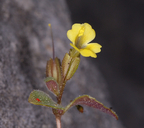Taxon Report
Erythranthe taylorii NesomShasta limestone monkeyflower |
 © 2016 Steve Matson |
Taxon Summary
Erythranthe taylorii, commonly known as Shasta limestone monkeyflower, is a annual herb in the Phrymaceae that is found only in California. It occurs within Cismontane woodland, and Lower montane coniferous forest, growing at elevations from 355 to 1070 meters. Erythranthe taylorii is ranked 1B.1, Plants Rare, Threatened or Endangered in California and Elsewhere; Seriously threatened in California.Classification
|
Scientific Name: |
Erythranthe taylorii Nesom |
|
Common Name: |
Shasta limestone monkeyflower |
| Family: | Phrymaceae |
| Element Code: | PDPHR01080 |
| USDA Plants Symbol: | |
|
Synonyms/Other Names: |
|
Ecology and Life History
| Lifeform: | annual herb |
| Blooming Period: (Feb)Apr-May | (Feb)Apr-May |
| Elevation: | 355-1070 (1165-3510) |
| General Habitats: | Cismontane woodland, Lower montane coniferous forest |
| Microhabitat: | Carbonate, Openings, Rocky |
| Microhabitat Details: | carbonate crevices and rocky outcrops |
Conservation Status
| CA Rare Plant Rank: | 1B.1 |
| Global Rank: | G2 |
|
State Rank: |
S2 |
| State List: | None |
| Fed List: | None |
| Other Status: | |
|
CRPR Changes: |
|
Occurrence Data from the CNDDB
| Total Occurrences: | 31 |
| Element Occurrence Ranks: | |
| Excellent (A) | 0 |
| Good (B) | 27 |
| Fair (C) | 1 |
| Poor (D) | 0 |
| None (X) | 0 |
| Unknown (U) | 3 |
| California Endemic: True | |
| California Counties and Islands: Name (Code) | |
| Shasta (SHA) | |
| Quads: Name (Quad Code) | |
| Bohemotash Mtn. (4012274), Bollibokka Mtn. (4012282), Devils Rock (4012271), Girard Ridge (4112222), Hanland Peak (4012283), Minnesota Mtn. (4012272), O'Brien (4012273), Shoeinhorse Mtn. (4112211), Tombstone Mtn. (4112213) | |
Threat List Data from the CNDDB
| Threat List Total: | 4 | |
| EOs with Threat Listed: | Total EOs | % of EOs |
| 3 | 10 % | |
| Road/trail construction/maint. | 2 | 6% |
| Biocides | 1 | 3% |
| Logging | 1 | 3% |
| Non-native plant impacts | 1 | 3% |
Notes
| Known only from the Shasta Lake region. Threatened by Shasta Dam raise and reservoir enlargement. Possibly threatened by road maintenance, mining, alteration of fire regimes, and non-native plants. Previously identified, and similar to, E. alsinoides and E. pulsiferae. Also similar to E. ampliata, an Idaho endemic that is hypothesized to be its closest relative. Not in TJM 2. See Phytoneuron 2013-43:1-10 (2013) for original description. |
|
Threats: |
|
Taxonomy: |
Selected References
| CRPR List Addition on 2013-10-16 |
| Erythranthe taylorii account for potential Species of Conservation Concern evaluation (2021) |
Citation
California Native Plant Society, Rare Plant Program. 2025. Rare Plant Inventory (online edition, v9.5.1). Website https://www.rareplants.cnps.org [accessed 14 December 2025].